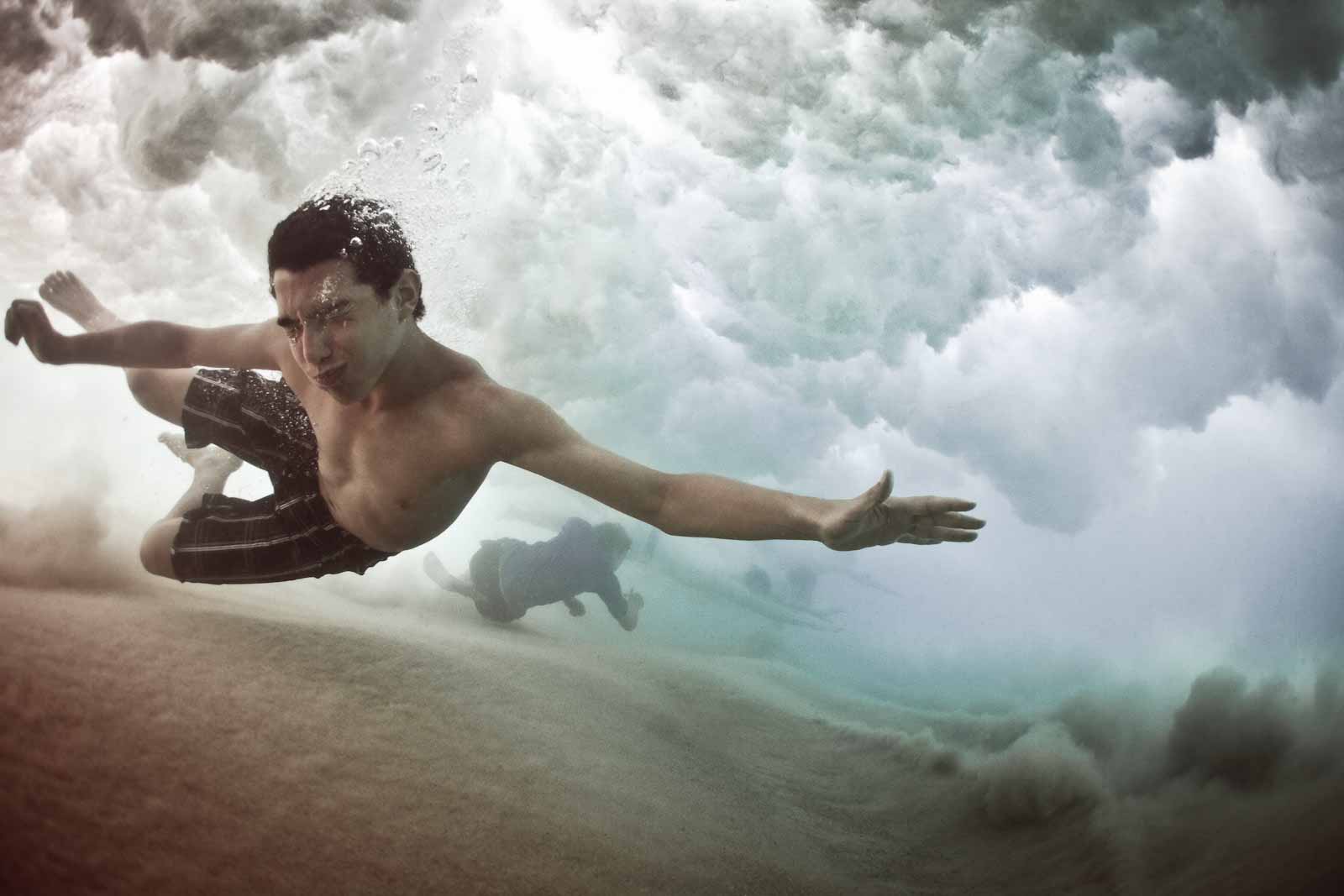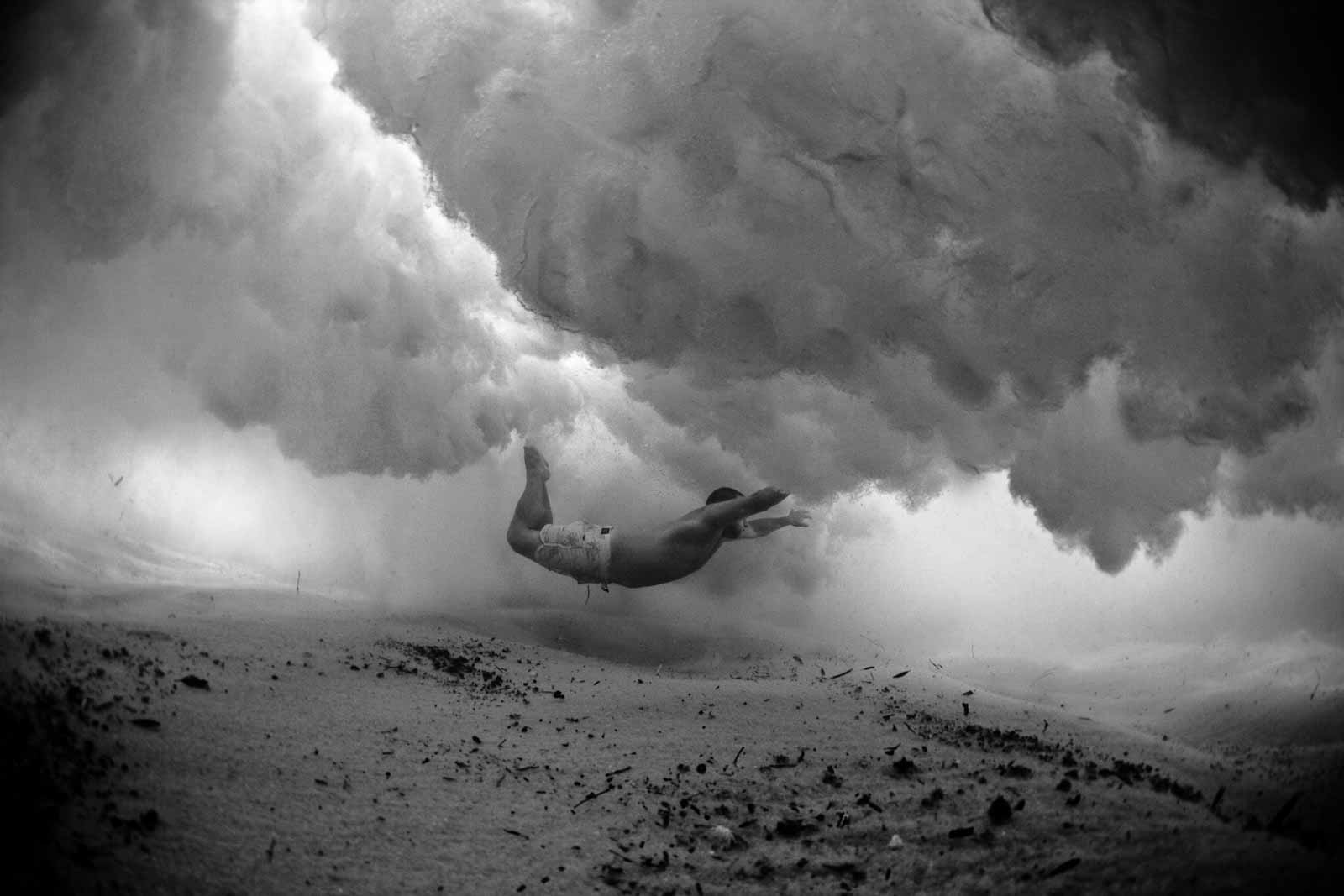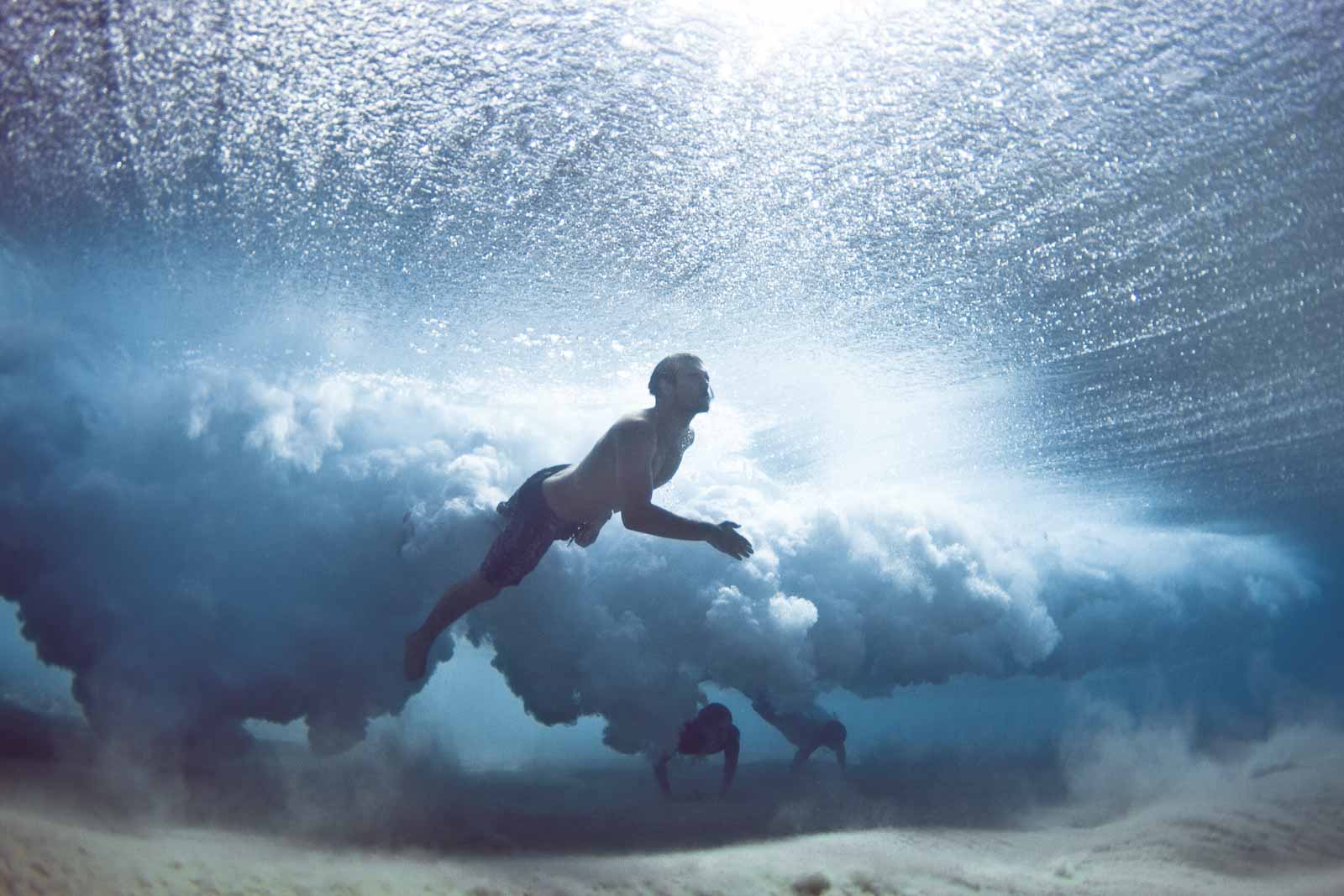The Underwater Project :: Life Below the Surface
The Submerged Lens.
By Daisy Dumas
A haze of smashed blues and whites, the bright sting of sunlight and a briny hit. The wave rolls onwards, lurching forwards with a power that seems so benign from afar. It throws itself in a powerful lunge, crashes down and topples everything in its path – but for the ocean swimmers who know that to survive a wave is to dive deep.
Grip the sand, they remind themselves. Go low, stay low. Their faces spontaneously contort, their muscles tightening in reaction to the saltwater and the struggle for power in the ocean.
They surface when the surge has passed. Then breathe.
They don’t know that a camera has captured it all; from straining arms clawing at sand to eyes squeezed tightly shut against the bite of salt.
Mark Tipple, 29, holds the 11-pound camera as steady as possible in the melting foam and makes his way to the shore.
“Surf photography’s been around forever, I wanted something different” Mark says.
“I was bored of shooting empty waves. One day, I was caught inside by a big wave and as I dove underwater I suddenly thought I’d see what the kids next to me were going through – I turned the camera on them.”
That day, it took just one picture, ‘Escape’, to transform the way Mark viewed the ocean – the split-second decision to turn his camera on the swimmers setting the ball rolling for a series that has captured imaginations across the globe.
“That first image remains one of my strongest – I realised immediately that it was close to what I had been looking for ten years ago on my first surfing road trip.”
We’re in Bronte, Sydney, the cityscape a long way off from Mark’s home in Port Lincoln, South Australia. Like a fish out of the water, I can’t help thinking the city isn’t where this tall, lean, dreadlocked surfer belongs.
Mark’s bond with the ocean has taken him around Australia, Indonesia, the Pacific Islands, and the length of North America’s West Coast to Alaska. The ocean is in his blood – his brother’s a marine biologist and his father was a nomadic surfer who, like the rest of the family, has always lived next to the ocean. Photography was a way to structure the random travel, to give his journeys a goal. It was a frustration with “stock-standard surf shots” that led to Escape – and, eventually, The Underwater Project.
Since Mark Tipple began, by happy accident, to photograph ocean swimmers underwater, he has come to recognise a physical and emotional fragility in people that so often remains hidden. The images portray a stillness that betrays the violent energy of the situation, but that tap into one of Tipple’s original – and unpredictable – inspirations for the project: war photography.
“I wanted to focus on the same raw emotion as the conflict photographs I had seen, to capture genuine expression; to see people being real. Usually, the camera’s presence gets in the way, people don’t forget the camera, they pose and feel self-conscious. However, over time or through a greater elemental presence than the camera, genuine emotion is unveiled, and poses are stripped away.”
The struggle for survival underwater is a way to break down this formality, a catalyst for breaking down social inhibitions. “Underwater, people are concentrating on survival – the camera is the last thing on their mind, and real emotions are revealed without trappings.”
“I didn’t know anything about these swimmers and suddenly I was seeing raw emotion, a struggle. The same wave can be beautiful and perfect and in a split second it can switch to end-of-the-world Armageddon-style violence.”
Mark has had his fair share of struggles, too.
“When we shoot back in SA, I only shoot with people I trust as I don’t want to put them in danger. My mate Scott and I went to a remote beach near Port Lincoln – the waves had about 8 to10-foot faces, but when we got out there we realised they were about twice as big as we had expected. We got absolutely pounded, managed to get three shots in the 20 minutes before the waves kicked us back to shore. The ocean beat us. I’ve landed on people, I’ve run into them underwater, I’ve stayed underwater too long and surfaced dizzy from a lack of oxygen, I’ve lost my camera. And I was almost landed on by a dolphin…”
His work has taken him to California and Mexico, where he filmed a short movie, Shark Diver, featuring his brother, Luke, a renowned shark expert.
“After filming Shark Diver, I was back in SA, in the water. A bunch of fins came close but we knew they were dolphins, as sharks rarely swim in packs. I was waiting for the next wave when a dolphin flew from the back of the wave towards me and landed less than three feet away. I didn’t think much of it until I saw the shots later – there was even a rainbow in the picture.”
Serendipitous as they may be, the majority of shots focus on survival and there’s a clear subdivision of powers at play. “There are those who are fighting against the ocean, they know how to handle themselves and the waves. Then there are those who are dominated by the ocean, the rookies who aren’t sure how to stand up to its power.”
The pictures have come to document the changing face of the ocean, the seasons and moon as power-brokers – and man as a small element in the face of the ocean’s might.
“The summer is full of skimpily dressed swimmers, so vulnerable in the face of the elements. They are more exposed, the ocean could have complete dominance over those swimmers – the pictures show a frailty in the face of the ocean. In the winter, there is a shift to people who are stepping it up – people in wetsuits, in flippers, they are prepared.”
The ultimate sad irony, of course, being man’s dominance over the ocean in terms of climate change and pollutants – and how unprepared for the potential of acidified oceans we really are.
In the end, he says the shots are “just pretty pictures, they’re context-less.” Out of the search for meaning has come Mark’s current project, Ocean.
Whilst filming Shark Diver in California and Mexico, Mark worked alongside Scott Cassell, renowned marine biologist and environmentalist. “Scott told me that we could have as little as twenty years until the ocean kills us. It was a wake up call.” He soon saw the potential of using ocean photography as a call to arms, a merging of humanitarian concerns with the beauty of nature. “I realised that humanitarian concerns can’t be divorced from environmental ones – they’re one and the same.”
And so began the Ocean series, Mark’s next project, upon which he has been working for the last few months. The culmination of attempting to combine humanitarian work with his love of the ocean, the series is about “giving the ocean a human face” and focuses on multimedia stories about people who base their lives around the ocean – the ocean is their work, pleasure and survival, those for whom “the ocean is ingrained in who they are.”
He has spent weeks filming surfboard shapers and pro surfers, lifeguards and surf photographers, a recreational fisherman and surfer, a nomadic surfer, a marine biologist, a Fijian family who live on and from fish and will next capture similar stories from people in nations who are most at risk from sea level change.
He hopes the series of 12 seven-minute films, all produced from his room in Bronte, will not only encourage introspection about the place of the ocean in our lives – and a possible future without its spectacular presence – but will also push corporations to invest in ocean research. It’s hard to comprehend here in Bronte with its perfect beach and suntanned lifeguards, but there’s more than swimming and surfing at stake.
“We’re Australian. The ocean is so much a part of who we are.” He quietly says as he stares out beyond the arc of golden sand and towards the distant waves, the city of four million behind us.
“I’m worried about our lifestyles. My life is the ocean – I don’t know what I’d do if it wasn’t there.”
























